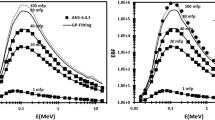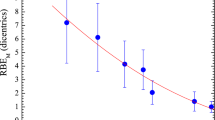Abstract
The aim of this work was to study photon and electron dose distributions in a phantom filled with water using the Monte Carlo Geant4 tool for electron energies ranging from 1 to 21 MeV and for photon energies ranging from 1.25 MeV to 25 MeV, corresponding to conventional radiotherapy Linac energies. The results of the Geant4 calculations were validated based on the relevant experimental data previously published. The results obtained were fitted and analytical models of dose distributions were developed for gamma radiation and electrons. For each of these models, one-dimensional (including dose depth profiles as a function of the depth inside the phantom) and two-dimensional (including the dose distribution as a function of depth and lateral position inside the phantom) dose distributions have been considered. Results are presented for photons and electrons of various energies. The coefficient of determination \(R^{2}\) illustrates an excellent match between the developed analytical model and the Geant4 results. It is demonstrated that the analytical models developed in the present study can be applied in various fields such as those used for calibration applications and radiation therapy. It is concluded that the analytical models developed allow for quick, easy and reliable clinical dose estimates and offer promising alternatives to the standard tools and methods used in radiotherapy for treatment planning.








Similar content being viewed by others
Change history
24 February 2021
A Correction to this paper has been published: https://doi.org/10.1007/s00411-021-00893-y
References
Agostinelli S, Allison J, Amako K, Apostolakis J, Araujo H, Arce P, Asai M, Axen D, Banerjee S, Barrand G, Behner F, Bellagamba L, Boudreau J, Broglia L, Brunengo A, Burkhardt H, Chauvie S, Chuma J, Chytracek R, Cooperman G, Cosmo G, Degtyarenko P, Dell’Acqua A, Depaola G, Dietrich D, Enami R, Feliciello A, Ferguson C, Fesefeldt H, Folger G, Foppiano F, Forti A, Garelli S, Giani S, Giannitrapani R, Gibin D, Gomez Cadenas JJ, Gonzalez I, Gracia AG, Greeniaus G, Greiner W, Grichine V, Grossheim A, Guatelli S, Gumplinger P, Hamatsu R, Hashimoto K, Hasui H, Heikkinen A, Howard A, Ivanchenko V, Johnson A, Jones FW, Kallenbach J, Kanaya N, Kawabata M, Kawabata Y, Kawaguti M, Kelner S, Kent P, Kimura A, Kodama T, Kokoulin R, Kossov M, Kurashige H, Lamanna E, Lampen T, Lara V, Lefebure V, Lei F, Liendl M, Lockman W, Longo F, Magni S, Maire M, Medernach E, Minamimoto K, Mora de Freitas P, Morita Y, Murakami K, Nagamatu M, Nartallo R, Nieminen P, Nishimura T, Ohtsubo K, Okamura M, O’Neale S, Oohata Y, Paech K, Perl J, Pfeiffer A, Pia MG, Ranjard F, Rybin A, Sadilov S, Di Salvo E, Santin G, Sasaki T, Savvas N, Sawada Y, Scherer S, Sei S, Sirotenko V, Smith D, Starkov N, Stoecker H, Sulkimo J, Takahata M, Tanaka S, Tcherniaev E, Safai TE, Tropeano M, Truscott P, Uno H, Urban L, Urban P, Verderi M, Walkden A, Wander W, Weber H, Wellisch JP, Wenaus T, Williams DC, Wright D, Yamada T, Yoshida H, Zschiesche D (2003) Geant4—a simulation toolkit. Nucl Instru Methods Phys A 506:250–303
Almond PR, Biggs PJ, Coursey BM, Hanson WF, Huq MS, Nath R, Rogers DW (1999) AAPMs TG-51 protocol for clinical reference dosimetry of high-energy photon and electron beams. Med Phys 26:1848–1869
Berger MJ (1956) Proceedings of Shielding Symposium, Naval Radiological Defense Laboratory, USNRDL Reviews and Lectures No. 29
Blanpain B, Mercier D, Barthe J (2007) Calcul par réseaux de neurones de la dose déposée en radiothérapie par un faisceau fin dans un volume hétérogène, Majecstic 2007, Caen, France, pp. 151–159
Capo MA (1958) Polynomial approximation of gamma ray buildup factors for a point isotropic source, General Electric Company, Aircraft Nuclear Propulsion Department, Atomic Products Division, and Nuclear Development Corporation of America
Chibani O (2001) New photon exposure buildup factors. Nucl Sci Eng 137:215–225
Eldib AA, ElGohary MI, Fan J, Jin L, Li J, Ch M-M, Elsherbini NA (2010) Dosimetric characteristics of an electron multileaf collimator for modulated electron radiation therapy. J Appl Clin Med Phys 11(2):5–22
El Barouky J, Fournier-Bidoz N, Mazal A, Fares G, Rosenwald JC (2011) Practical use of Gafchromic EBT films in electron beams for in-phantom dose distribution measurements and monitor units verification. Eur J Med Phys 27:81–88
Faddegon BA, Sawkey D, Tuathan OS, Malcolm M, Carl R (2009) Treatment head disassembly to improve the accuracy of large electron field simulation. Med Phys 36:4577–4591
Geant4 Collaboration (2013a) Geant4 Physics Reference Manual, Version: geant4 10.0,6
Geant4 Collaboration (2013b) Geant4 User’s Guides for Application Developer, Version: geant4 10.0,6
Goldstein H, Wilkins JE (1970) Attenuation of gamma-rays and neutron in reactor shields, US Government Printing Office
IAEA (2000) Absorbed dose determination in external beam radiotherapy: an international code of practice for dosimetry based on standards of absorbed dose to water, IAEA Technical Report 398
Jaeger RG, Blizard EP, Chilton AB, Grotenhuis M, Honig A, Jaeger TA, Eisenlohr HH (1968) Engineering compendium on radiation shielding. In: Shielding fundamentals and methods. Vol I, IAEA, Springer, Berlin
Kleppinger EW, Yates SW (1987) Attenuation of gamma rays in binary compounds. J Chem Educ 64:172–174
Li JS, Yang J, Qin L, Xiong W, Ma CM (2004) MCBEAM a Monte Carlo tool for beam simulation. In: Proceedings of the 14th International Conference on the Use of Computer in Radiation Therapy (ICCR), Seoul, South Korea, Jeong Publishing
Ma CM, Li JS, Pawlicki T, Jiang S, Deng J, Lee M, Koumrian T, Luxton M, Brain S (2002) MCSIM: a Monte Carlo dose verification tool for radiation therapy treatment planning and beam delivery. In: 44th AAPM Annual Meeting. Montreal
MATLAB 8.0 and Statistics Toolbox 8.1, Release 2012b, the MathWorks, Inc., Natick, Massachusetts, United States
Podgorsak EB (2005) Radiation oncology physics: a handbook for teachers and students, International Atomic Energy Agency Vienna (IAEA)
Sarrut D, Bardiès M, Nicolas Boussion N, Freud N, Jan S, Létang JM, Loudos G, Maigne L, Marcatili S, Mauxion T, Papadimitroulas P, Perrot Y, Pietrzyk U, Robert C, Schaart DR, Visvikis D, Buvat I (2014) Review of the use and potential of the GATE Monte Carlo simulation code for radiation therapy and dosimetry applications. Med Phys 41. https://doi.org/10.1118/1.4871617
Taylor JJ (1954) Application of gamma ray buildup data to shield design, Bettis Atomic Power Laboratory, U.S. Atomic Energy Commission., Westinghouse Electric Corporation. Atomic Power Division
Trubey DK (1968) Use of ICRU-defined quantities and units in shielding, OKA Ridge National Laboratory, Radiation Shielding Information Center
Trubey DK, Eisenhauer CM, Foderaro A, Gopinath DV, Harima Y, Hubbell JH, Shure K, Su S (1991) Gamma ray attenuation coefficient and buildup factors for engineering materials. Am Nucl Soc ANSI/ANS-6.4.3
Zeb J, Arshed W, Ahmad SS (2007) Radiation dose reduction by water shield. W-Shielder Manual, Health Physics Division, Pakistan Institute of Nuclear Science & Technology, IAEA1417/01
Author information
Authors and Affiliations
Corresponding author
Ethics declarations
Conflict of interest
The authors declare that they have no conflict of interest.
Additional information
Publisher's Note
Springer Nature remains neutral with regard to jurisdictional claims in published maps and institutional affiliations.
The original online version of this article was revised: The units (of particle energy) have been updated from "meV" to "MeV".
Appendices
Appendix
Methods of calculation of the buildup factor B
There are currently several methods for calculating the buildup factor B. Among these methods, one can use:
One of the simplest and least accurate approximations, the linear formula given in Eq. (A1) (Turbey 1968):
where x is the depth in the material of interest.
The linear formula is generally valid only over very limited distances. The value of k is readily derived from the original data by means of formulae. A2:
A good compromise between accuracy and computational complexity is offered by the Berger formula (Eq. A3) (Taylor 1954):
where coefficients a and b are described also in the reference (Taylor 1954).
The formula of Capo is given in Eq. (A4) (Capo 1958):
Capo has derived values of the coefficients in Eq. (A4). The results given by Capo match Goldstein and Wilkins’s point source buildup factors (Goldstein et al. 1954) very closely over the whole range of distances involved (out to 15 or 20 mean free paths), and for energies from 0.5 to 10 MeV. In Eq. (A4), the coefficients βi are also given Capo (1958).
The most precise formula, which is used in most cases, is the so-called Taylor formula (Eq. A5) (Berger 1956):
where the coefficients A, α1 and α2 are not dependent on depth x. These coefficients do not have any physical significance. The coefficients A, α1 and α2 are described in Jaeger et al. (1968).
Rights and permissions
About this article
Cite this article
Elj, S., Ben-Ismail, A. & Fayache, M.S. Development and validation of an analytical model allowing accurate predictions of gamma and electron beam dose distributions in a water medical phantom. Radiat Environ Biophys 60, 151–162 (2021). https://doi.org/10.1007/s00411-020-00877-4
Received:
Accepted:
Published:
Issue Date:
DOI: https://doi.org/10.1007/s00411-020-00877-4




